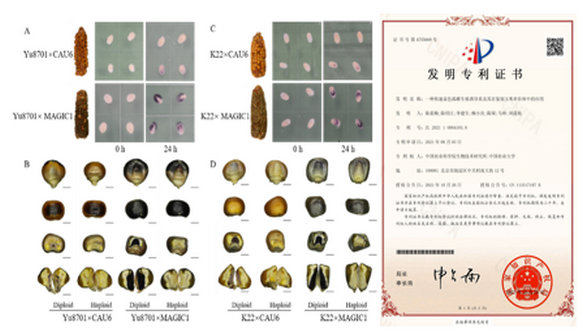Recently, a collaborative research of CropFunctionalGenomeResearchCenterof Biotechnology Research Institute, CAAS and NationalMaizeImprovementCenterofChinaAgriculturalUniversity establisheda powerfulhaploididentificationsystemthat can be appliedto DH breedingprograms, Maize Anthocyanin Gene InduCer 1 (MAGIC1) and MAGIC2,whichprovidegreaterabilitytodistinguishhaploidsfromdiploids.The study was published in Plant Journalwith the title of "Co-expressionof transcriptionfactorsZmC1and ZmR2establishesan efficientand accurate haploidembryo identificationsysteminmaize".
Because of their high efficiency during chromosome doubling, immature haploid maize embryos are useful for doubled haploid production. TheR1-njmarker is commonly used in doubled haploid breeding and has improved the efficiency of haploid identification. However, its effectiveness is limited by genetic background and environmental factors. We addressed this technical challenge by developing an efficient and accurate haploid embryo identification marker through co-expression of two transcription factors (ZmC1andZmR2) driven by the embryo-aleurone-specific bidirectional promoter PZmBD1; these factors can activate anthocyanin biosynthesis in the embryo and aleurone layer during early seed development. We developed the new haploid inducer, Maize Anthocyanin Gene InduCer 1 (MAGIC1), by introducing the transgenes into the haploid inducer line CAU6. MAGIC1 could identify haploids at 12 days after pollination, which is nine days earlier than CAU6. Importantly, MAGIC1 increased haploid identification accuracy to 99.1%, compared with 88.3% for CAU6. In addition, MAGIC1 could effectively overcome the inhibition of anthocyanin synthesis in some germplasms. Furthermore,an upgraded anthocyanin marker was developed fromZmC1andZmR2to generate MAGIC2, which could identify haploids from diploids due to differential anthocyanin accumulation in immature embryos, coleoptiles, sheaths, roots, leaves, and dry seeds. This haploid identification system is more efficient and accurate than the conventionalR1-nj-basedmethod, it simplifies the haploid identification process. Therefore, this system provides technical support for large-scale doubled haploid line production.
Liu Xiaoqing, an associate professorof Biotechnology Research Institute, and Chen Chen, a PhD student of ChinaAgriculturalUniversity,are the co-first authors. Chen Rumei, a professor of Biotechnology Research Institute, and Chen Shaojiang, a professor of ChinaAgriculturalUniversity, are the co-corresponding authors. Li Jiansheng, a professor of ChinaAgriculturalUniversity,ThisworkwassupportedbytheChinaAgricultureResearchSystem(CARS-02), NationalSpecialProgramforGMODevelopmentofChina(2016ZX08003-002)and2020ResearchProgramofSanyaYazhouBayScienceandTechnologyCity(SK JC-2020-02-03)andBeijingPostdoctoralSustentationFund(2022-020).

|